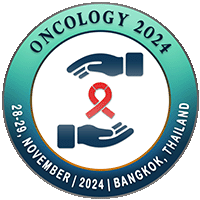
Kavuma Awusi
Uganda Cancer Institute, UgandaTitle: A retrospective analysis of the impact of HIV infection on outcomes of locally advanced cervical cancers treated with either conventional or Hypo-fractionated radiotherapy
Abstract
Purpose: We annually treat over 800 new cervical cancer patients, majority (»60%) with locally advanced disease and »40% of these are infected with HIV. To optimally care for this large numbers in low-income settings, is difficult. From July 2011, we started using 45.0Gy/15# hypo-fractionated radiotherapy (HFRT) as a substitute to 50.0Gy/25# conventional fractionated radiotherapy (CFRT), for the treatment of locally advanced cervical cancer (LACC). This study aims at comparing the 5-year treatment outcomes between patients with LACC, known HIV sero-status, treated with either CFRT or HFRT.
Methodology: A retrospective study was conducted according to demographic/clinical data, radiotherapy-fractionations and outcomes. Factors considered were FIGO stages IIB–IIIB, known HIV sero-status and had completed external beam radiotherapy (EBRT) and intra-cavitary brachytherapy (ICBT). The primary-endpoint was overall-survival; the secondary-endpoints were toxicity and compliance.
Results: The study included 221 patients. Squamous cell carcinomas were 95.1% and adenocarcinomas 2.3%. The Median age was 45.0 IQR=(38.0;52.0) years. Stages IIB,IIIA,IIIB were 38.9%,6.3%,54.8% respectively. HIV-positive and negative were 87(39.4%) and 134(60.6%). Chemo-radiation was administered in 100(45.2%) and (52)52.0% completed chemotherapy. CFRT/HFRT were 116(52.5%)/105(47.5%). At 24 months, the overall-response was 54.1% for HIV-negative compared to 45.0% for HIV-positive (p-value 0.262). There was no significant differences in acute/late toxicity-grades ? 2 for HIV-negative/positive treated with HFRT/CFRT. At 60 months, the survival-probabilities were 45.7% and 27.7% for HIV-negative and positive treated with CFRT (p-value=0.006), while it was 44.2% and 30.7% for HIV-negative and positive treated with HFRT (p-value=0.048) respectively. Conclusions: For the treatment of LACC with known HIV-serology, there was no significant statistical difference in terms of response, toxicity and compliance between CFRT and HFRT. However, the difference in overall-survival between HIV-negative and positive was significant.
Biography
Awusi Kavuma (BSc, MSc, M.Med.Sc, PhD), is the chief medical physicists at the radiotherapy department of Uganda Cancer Institute and pioneer staff-member who in 1995 started radiotherapy services in Uganda. Engaged in several activities including commissioning, treatment planning QA checks, and specification of radiotherapy equipment. He is a member of the African Radiation Oncology Group (AFROG) / secretary 2016-2018. Was involved as IAEA-Uganda national-counterpart for projects RAF-6044 (Medical physics in support of cancer management), RAF-6050 (Improving access to quality cancer management through sustainable capacity building, RAF-6055 (Improving the quality of radiotherapy in the treatment of frequently occurring cancers). Has written two book chapters: (1) Status of Radiotherapy Around the World – ‘’Sub-Saharan Africa’’, in Radiotherapy in Cancer Care: Facing the Global Challenge, edited by E. Rosenblatt and E. Zubizarreta, IAEA: Vienna – Austria; pg 398-403 (2017).and (2) Cancer of the Oesophagus, in Tropical Hemato-Oncology, edited by Jean-Pierre, Bernad Carme, Pierre Couppie, Mathieu Nacher and Catherine Thieblemont, Springer. pg 315-322 (2015). Kavuma is currently serving as a reviewer for Physica-Medica: European Journal of Medical physics. He is the PI of single institution study: Clinical outcomes of conventional versus hypo-fractionated pelvic radiotherapy for locally advanced cervical cancer.

